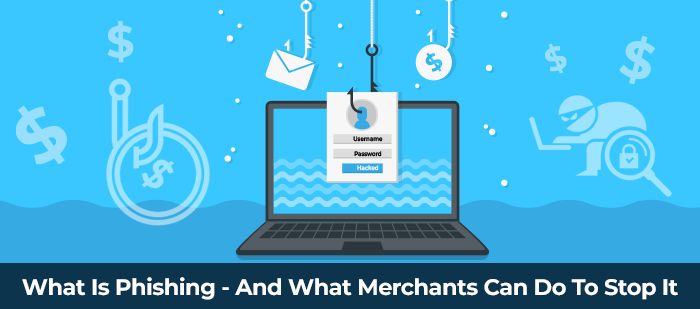
What is phishing? In its simplest form, it is a form of cybercrime where criminals use email, text messages, and malicious websites to try to get people to share personal information, such as bank account numbers and passwords. It is a serious threat to businesses and consumers alike, and merchants need to be aware of the risks and take action to protect themselves and their customers. In this blog post, we will discuss what phishing is, the types of threats it poses, and what merchants can do to stop it.
What is phishing?
Phishing is a type of online fraud where criminals use emails, websites, and other digital communication to attempt to steal your personal information, such as passwords, account numbers, or credit card details. The goal of the scam is to trick you into giving away your personal data. Phishing can also be used to spread malicious software (malware) or infect computers with ransomware.
Phishing attacks are becoming increasingly sophisticated and more difficult to detect. Hackers use social engineering tactics, like pretending to be from a company you trust, in order to get you to click on a link or open an attachment that could lead to a malicious website or download malware. They may even call you on the phone and pretend to be from a legitimate company in order to get your personal information.
The most common forms of phishing include emails, SMS messages, and malicious websites. In each case, the attacker will try to convince you to provide your personal information. It’s important to remember that legitimate companies will never ask for sensitive information like passwords or credit card numbers via email or over the phone.
How do phishing scams work?
Phishing is a type of cyber-attack that involves the use of malicious emails and websites to trick unsuspecting victims into giving away sensitive information or making fraudulent purchases. The goal of a phisher is to gain access to private data, such as passwords, credit card numbers, and bank account information.
The most common way in which phishers operate is by sending out fake emails that appear to be from legitimate organizations, such as banks or online stores. These emails typically contain links to a malicious website or ask recipients to provide personal information.
In some cases, phishers also create fake websites that look identical to the original sites of legitimate organizations. When unsuspecting victims visit these fake sites, they may unknowingly enter their usernames and passwords, unknowingly exposing themselves to fraud.
Phishers can also use malicious software, called malware, to infect a victim’s computer. Once the computer is infected, the phisher can gain access to the user’s personal data, such as passwords and banking information. Phishers may also use this malware to send out spam messages or to launch further attacks against unsuspecting victims.
By taking advantage of human vulnerability and exploiting weaknesses in technology, phishers are able to target vast numbers of potential victims in order to gain access to sensitive information and make fraudulent purchases. As such, it is important for individuals and merchants alike to remain vigilant and take measures to protect themselves from phishing scams.
Our Latest Blogs
● 5 Tips To Protect Your Business Against Click Fraud
● How to Spot a Refund Service Scammer – Chargeback Expertz
● 8 Common Merchant Mistakes When Handling Chargebacks
● Top 5 Holiday Fraud Schemes You Need To Be Aware
How can I protect myself from phishing attacks?
The best way to protect yourself from phishing attacks is to be aware of how they work. You should always be sceptical of any unsolicited emails, text messages, or social media messages that offer you something that seems too good to be true. Be especially wary of messages that ask for personal or financial information, such as passwords, credit card numbers, Social Security numbers, or bank account numbers.
Another important step in protecting yourself from phishing attacks is to verify the source of any messages you receive. Before clicking on a link or opening an attachment in an email, make sure it’s from someone you know and trust. If you’re not sure, contact the sender directly through another means of communication to confirm the validity of the message.
You should also be sure to keep your computer and other devices up to date with the latest security updates and antivirus software. This will help ensure your devices are better protected against any malicious software that may come as part of a phishing attack. Additionally, be sure to use strong passwords and two-factor authentication when available.
Finally, if you think you may have been the victim of a phishing attack, contact your bank or credit card provider right away to report it. You may also want to contact local law enforcement or file a complaint with the Federal Trade Commission.
What can merchants do to stop phishing attacks?
There are a number of steps that merchants can take to help protect their customers from phishing attacks.
The first is to educate their customers about the risks associated with phishing and the potential consequences of falling victim to a scam. It’s important for merchants to explain the types of phishing emails that their customers may encounter and what actions they should take if they suspect a phishing attack is taking place.
![]()
Email us anytime!
Email customer service 24/7
![]()
Call us anytime!
Reach customer care 24/7 at +1 (888) 901-8653
The second is for merchants to make sure their customers’ data is as secure as possible. This means using strong passwords, two-factor authentication, and other security measures when it comes to customer accounts.
Third, merchants should employ technologies such as anti-spam filters, malware scanners, and website authentication tools to identify suspicious activity on their websites and help protect customers from potential phishing attacks.
Fourth, merchants should ensure that all emails sent to customers are legitimate and come from a trusted source. If a customer receives an email that looks suspicious, they should report it to the merchant immediately.
Finally, merchants should use services such as cyber insurance, which can help protect them in the event that they suffer a loss due to a successful phishing attack.
By taking these steps, merchants can go a long way toward protecting their customers from falling victim to phishing scams.
Final Words
Phishing is a serious threat to online businesses and consumers alike. With the increasing sophistication of phishing techniques, it’s essential for both merchants and consumers to be aware of the risks and take steps to protect themselves. Merchants should take proactive measures to protect customer information and ensure customers have a safe shopping experience. Consumers should remain vigilant and take steps to protect themselves against phishing attacks, such as watching out for suspicious emails and never clicking on links sent in unsolicited emails. By taking steps to prevent phishing, businesses and consumers alike can help keep their information and finances secure.


